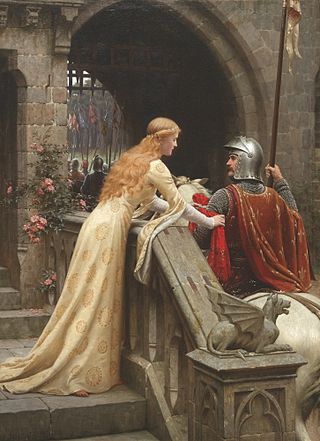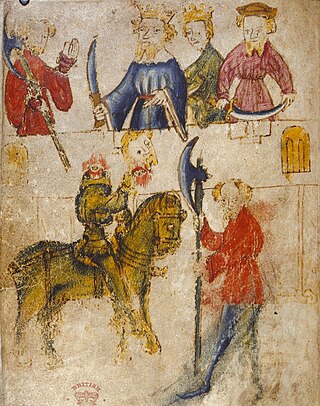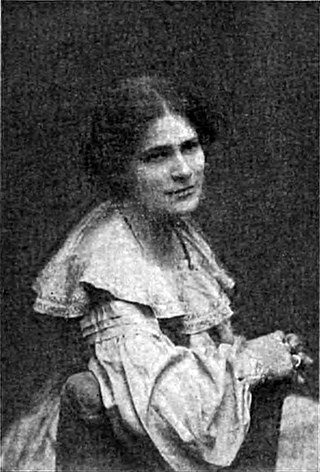Related Research Articles

Courtly love was a medieval European literary conception of love that emphasized nobility and chivalry. Medieval literature is filled with examples of knights setting out on adventures and performing various deeds or services for ladies because of their "courtly love". This kind of love was originally a literary fiction created for the entertainment of the nobility, but as time passed, these ideas about love spread to popular culture and attracted a larger literate audience. In the high Middle Ages, a "game of love" developed around these ideas as a set of social practices. "Loving nobly" was considered to be an enriching and improving practice.

The Green Knight is a heroic character of the Matter of Britain, originating in the 14th-century poem Sir Gawain and the Green Knight and the related medieval work The Greene Knight. His true name is revealed to be Bertilak de Hautdesert in Sir Gawain, while The Greene Knight names him "Bredbeddle". The Green Knight later features as one of Arthur's greatest champions in the fragmentary ballad King Arthur and King Cornwall, again with the name "Bredbeddle".

As a literary genre, the chivalric romance is a type of prose and verse narrative that was popular in the noble courts of high medieval and early modern Europe. They were fantastic stories about marvel-filled adventures, often of a chivalric knight-errant portrayed as having heroic qualities, who goes on a quest. It developed further from the epics as time went on; in particular, "the emphasis on love and courtly manners distinguishes it from the chanson de geste and other kinds of epic, in which masculine military heroism predominates."
Dale C. Allison Jr. is a historian whose areas of expertise include the historical Jesus, the Gospel of Matthew, Second Temple Jewish literature, and the history of the interpretation and reception of the Bible. Allison is the Richard J. Dearborn Professor of New Testament at Princeton Theological Seminary. He was previously the Erret M. Grable Professor of New Testament at Pittsburgh Theological Seminary (1997-2013). From 2001-2014, he was an editor for the multi-volume Encyclopedia of the Bible and Its Reception.

Sir John Clanvowe was a Welsh diplomat, poet and chamber knight to Richard II. He was born to a Marcher family and was possibly of mixed Anglo-Welsh origin, holding lands that would lie in the present-day Radnorshire district of Powys and in Herefordshire.

Roger Sherman Loomis (1887–1966) was an American scholar and one of the foremost authorities on medieval and Arthurian literature. Loomis is perhaps best known for showing the roots of Arthurian legend, in particular the Holy Grail, in native Celtic mythology.

Blanchefleur is the name of a number of characters in literature of the High Middle Ages. Except for in Perceval, the Story of the Grail, Blanchefleur is typically a character who reflects her name—an image of purity and idealized beauty.

John Vincent Fleming is an American literary scholar and the Louis W. Fairchild '24 Professor of English and Comparative Literature, Emeritus, at Princeton University.
Seth Lerer is an American scholar and Professor of English. He specializes in historical analyses of the English language, and in addition to critical analyses of the works of several authors, particularly Geoffrey Chaucer. He is a Distinguished Professor Emeritus of Literature at the University of California, San Diego, where he served as the Dean of Arts and Humanities from 2009 to 2014. He previously held the Avalon Foundation Professorship in Humanities at Stanford University. Lerer won the 2010 Truman Capote Award for Literary Criticism and the 2009 National Book Critics Circle Award in Criticism for Children’s Literature: A Readers’ History from Aesop to Harry Potter.
Mimesis: The Representation of Reality in Western Literature is a book of literary criticism by Erich Auerbach, and his most well known work. It was written in German between 1942 and 1945, while Auerbach was teaching in Istanbul, Turkey, where he fled after being ousted from his professorship in Romance Philology at the University of Marburg by the Nazis in 1935, it was first published in Switzerland in 1946 by A. Francke Verlag, with an English translation by Princeton University Press following in 1953, since when it has remained in print.
Francis Lee Utley was a folklorist, linguist, medievalist, scholar of onomastics and literature, educator, and author.

Edith Rickert (1871–1938) was a medieval scholar at the University of Chicago. Her work includes the Chaucer Life-Records and the eight-volume Text of the Canterbury Tales (1940).
Anne Middleton was an American medievalist, and the Florence Green Bixby Professor of English at the University of California, Berkeley.
Richard Johann Utz is a German-born medievalist who has spent much of his career in North America. He specializes in medieval studies, and served as president of the International Society for the Study of Medievalism (2009–2020).
Nicholas Watson is an English-Canadian medievalist, literary critic, religious historian, and author. He is Henry B. and Anne M. Cabot Professor of English at Harvard University and chair of the Harvard English Department.
Jane Chance, also known as Jane Chance Nitzsche, is an American scholar specializing in medieval English literature, gender studies, and J. R. R. Tolkien. She spent most of her career at Rice University, where since her retirement she has been the Andrew W. Mellon Distinguished Professor Emerita in English.
Alastair J. Minnis is a Northern Irish literary critic and historian of ideas who has written extensively about medieval literature, and contributed substantially to the study of late-medieval theology and philosophy. Having gained a first-class B.A. degree at the Queen's University of Belfast, he matriculated at Keble College, Oxford as a visiting graduate student, where he completed work on his Belfast Ph.D., having been mentored by M.B. Parkes and Beryl Smalley. Following appointments at the Queen's University of Belfast and Bristol University, he was appointed Professor of Medieval Literature at the University of York; also Director of the Centre for Medieval Studies and later Head of English & Related Literature. From 2003 to 2006, he was a Humanities Distinguished Professor at Ohio State University, Columbus, from where he moved to Yale University. In 2008, he was named Douglas Tracy Smith Professor of English at Yale.
David Lyle Jeffrey is a Canadian-American scholar of literature and religion, currently a Distinguished Senior Fellow at the Baylor Institute for Studies in Religion. He was elected a Fellow of the Royal Society of Canada (1996-). In 2003 he was given the Lifetime Achievement Award of the Conference of Christianity and Literature.
Ruth Josephine Dean (1902–2003) was an American scholar of Anglo-Norman literature. Throughout her career, she worked hard to establish the legitimacy of Anglo-Norman literature as a subject of study, and her definitive work, Anglo-Norman Literature: A Guide to Texts and Manuscripts (1999) has won widespread praise for its substantial contribution to the study of literature.
Laura Alandis Hibbard Loomis was an American literary scholar and college professor who specialized in medieval English literature.
References
- 1 2 Saxon, Wolfgang (1992-06-30). "Dr. Durant Waite Robertson Jr., Influential Chaucer Scholar, 77". The New York Times . pp. D.25. Retrieved 2009-11-22.
- ↑ Robertson, D. W. Jr. (December 1946). "Certain Theological Conventions in Mannyng's Treatment of the Commandments". Modern Language Notes . 61 (8): 505–14. doi:10.2307/2909108. JSTOR 2909108.
- ↑ Robertson, D. W. Jr. (April 1947). "The Cultural Tradition of Handlyng Synne". Speculum . 22 (2): 162–85. doi:10.2307/2854724. JSTOR 2854724. S2CID 164179606.
- ↑ Robertson, D. W. Jr. (1946). "The Manuel des Péchés and an English Episcopal Decree". Modern Language Notes . 60 (7): 439–47. doi:10.2307/2910194. JSTOR 2910194.
- ↑ Critical approaches to medieval literature; selected papers from the English Institute, 1958-1959 (Columbia UP, 1960)
- 1 2 Staley, Lynn (1998-10-21). "Remembering Robbie: No one who heard D.W. Robertson read Chaucer can ever forget it". Princeton Alumni Weekly.
- ↑ Utley, Francis Lee (1965–66). "Robertsonianism Redivivus". Romance Philology . 19: 250–60. p. 250
- ↑ Newman, Francis X. (1968). The Meaning of Courtly Love. Albany: SUNY Press.
- ↑ Jeffrey, David Lyle (November 6–8, 2008). "Lessons from the Locker-Room on Courtly Love". The Family: Searching for Fairest Love. Notre Dame Center for Ethics and Culture: 10. Archived from the original on December 17, 2012. Retrieved 2011-03-21.
- ↑ Beidler, Peter G. (1996). The Wife of Bath. Boston: Bedford. p. 196. ISBN 978-0-312-11128-1.
- ↑ Gaylord, Alan T. (2006). "Reflections on D. W. Robertson Jr., and 'Exegetical Criticism.'". Chaucer Review . 40 (3): 311–33. doi:10.1353/cr.2006.0003. ISSN 0009-2002. S2CID 171039996. p. 320.
- ↑ Patterson, Lee (1987). Negotiating the Past: The Historical Understanding of Medieval Literature. Madison: U of Wisconsin P. pp. 26–36.
- ↑ Justice Steven, Steven (2009). "Who Stole Robertson?". PMLA. 124 (2). Modern Language Association: 609–15. doi:10.1632/pmla.2009.124.2.609. ISSN 0030-8129. S2CID 162260035. p. 614.
- ↑ Modern Language Association of America. Annual bibliography 1941-1992.